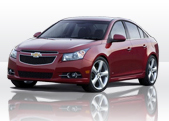
A short history of Chevrolet
The Founding of an Icon
Chevrolet's roots lie in the unlikely partnership between ousted General Motors founder William C. Durant and the renowned Swiss race car driver and engineer Louis Chevrolet. On November 3, 1911, they established the Chevrolet Motor Car Company in Detroit, Michigan. Durant saw this venture as an opportunity to regain his foothold in the automotive industry, while Chevrolet lent his name and design expertise.
Early success and competition with Ford
Chevrolet's initial offering was the luxurious and expensive Series C Classic Six. Though well-received, the model's high price tag limited sales. Learning from this, the company quickly shifted focus to more affordable vehicles, directly challenging Ford's dominance with the Model T. Chevrolet's introduction of the Series 490 in 1915 proved a game-changer, offering a stylish and reliable car at a competitive price.
Durant's shrewd business acumen propelled the brand forward. By 1918, Chevrolet's success had become so significant that it allowed Durant to purchase enough General Motors stock to retake control of the company he had founded. Chevrolet was seamlessly integrated into GM as a core division.
Expansion and innovation
Throughout the 1920s and 1930s, Chevrolet solidified its reputation for building dependable, value-oriented cars. It expanded its portfolio to include trucks, catering to a growing commercial market. This period also saw intense rivalry with Ford, as both brands sought market supremacy. During this time, Chevrolet introduced its iconic six-cylinder "Stovebolt" engine, renowned for its durability and power.
World War II and post-war prosperity
Like many automakers, Chevrolet shifted its focus during World War II, aiding the Allied war effort by manufacturing military vehicles and armaments. Following the war, the pent-up consumer demand spurred a boom in automobile sales. Chevrolet capitalized on this with the release of redesigned models. The Bel Air, launched in 1950, became a hallmark of 1950s American automotive design with its elegant lines and chrome accents.
Performance and muscle cars
The 1960s witnessed Chevrolet's entry into the performance car arena. The legendary Corvette, introduced in 1953 as a sporty roadster, gained a powerful V8 engine and established itself as an American icon. Models like the Camaro (1967) and Chevelle (1964) defined the muscle car era with their aggressive styling and potent engines.
Challenges and adaptation
The 1970s brought new challenges in the form of fuel crises and stricter emissions regulations. Chevrolet responded by developing smaller, more fuel-efficient vehicles like the Vega and Chevette. The decade also saw the introduction of the enduring Blazer (1969) SUV, paving the way for Chevrolet's future success in the sport utility market.
The modern era
From the 1980s onwards, Chevrolet continued to evolve its lineup to meet changing consumer needs and market trends. The Cavalier and Celebrity became mainstays of the compact and midsize car segments. Chevrolet expanded its truck and SUV offerings, solidifying its position in these highly lucrative markets. Innovations included the development of hybrid and electric vehicles like the Volt and the Bolt EV.
Chevrolet today
Chevrolet remains one of the world's largest and most recognized automotive brands. Its model lineup spans from practical cars like the Spark and Malibu to powerful performance vehicles such as the Corvette and Camaro. The Tahoe, Suburban, Silverado, and Colorado continue Chevrolet's legacy in the SUV and truck segments. The brand looks towards the future with a renewed focus on electrification and cutting-edge technology to ensure its continued relevance in the ever-evolving automotive landscape.





